Epson EH-TW420 LCD Projector Review
Epson EH-TW420 LCD Projector
At under £500, Epson's HD Ready EH-TW420 looks like a great value LCD projector. John finds out if it is.
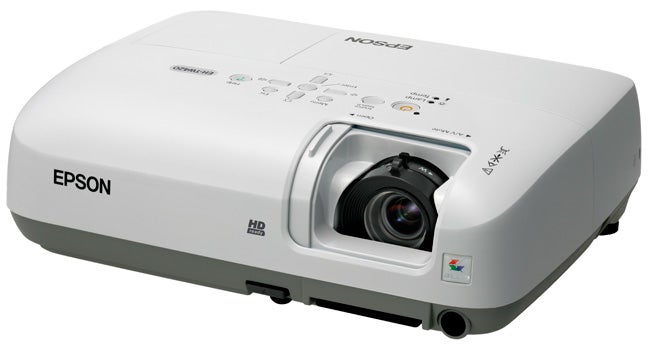
Verdict
Key Specifications
- Review Price: £439.99
It’s fair to say that the latest projector from Epson wears its heart very much on its sleeve – or rather, its startlingly low £440 price tag. This makes it the latest in a sudden glut of sub-£500 projectors to cross our test benches in recent weeks.
What’s more, unlike some of those other cheapo projectors, the TW420 appears to have been put together with film viewing particularly in mind – or at least that’s the impression you get from the Epson website, which openly describes the TW420 as a ‘Home Cinema Projector’. 
Rather confusingly the manual supplied with the TW420 refers to it instead as a multimedia projector, but we guess Epson’s online marketeers will probably have the most accurate handle on how Epson believes the projector should be perceived. The only worrying thing about the slight ‘multimedia’/home cinema confusion is that multimedia projectors seldom make great home cinema projectors, so given the love of TV and films that drives this section of our website, let’s hope the multimedia description on the manual doesn’t turn out to be a more accurate description of the TW420’s abilities.
First impressions are decent, thanks to the TW420’s quaint little design. It’s an unusually low-slung affair, chirpily finished in a gloss white and with its corners all rounded off to give it a ‘lifestyle’ look well suited to the average UK coffee table.
Its connectivity is reasonably promising too. A single HDMI is on hand for digital video duties, and this is joined by a D-Sub PC input (that also doubles – via a supplied adaptor – as a component video input), a composite video input, an S-Video input, and handy multimedia support in the form of an SD card slot, and two USB ports. Needless to say, I wasted no time in trying the SD card slot out for viewing the photos I’ve just brought back with me from the Consumer Electronics Show in Las Vegas. And I was pleased to discover that pictures are handled by a pretty decent slideshow system, complete with the facility to rotate pictures through 90 degrees. More good news finds the TW420 shipping with a carry case, and sporting a three-year warranty for extended peace of mind.
Turning to the TW420’s quoted specifications, the good news includes a perfectly decent (for under £500) HD Ready resolution of 1,280 x 720, a slightly longer than usual claimed lamp life of 3,000-4,000 hours, and a remarkably high claimed brightness output of 2,000 ANSI Lumens.
However, there’s also a bit of bad news. For instance, the level of optical zoom the projector supports is only 1.2x, which could make fitting the image onto a proper screen (rather than just a white wall) tricky for some people. As a ballpark guide, this means that you could enjoy a 60in image from between 1.9m-2.3m – hardly the biggest throw distance range we’ve come across.
The claimed running noise of 28dB is a touch louder than we’d like too, with the most disturbing discovery being the lack – so far as I could see, anyway – of any claimed contrast ratio. While it’s possible this could simply be an oversight on Epson’s part, it’s hard to resist the thought that this figure isn’t included because Epson doesn’t think it’s particularly attractive…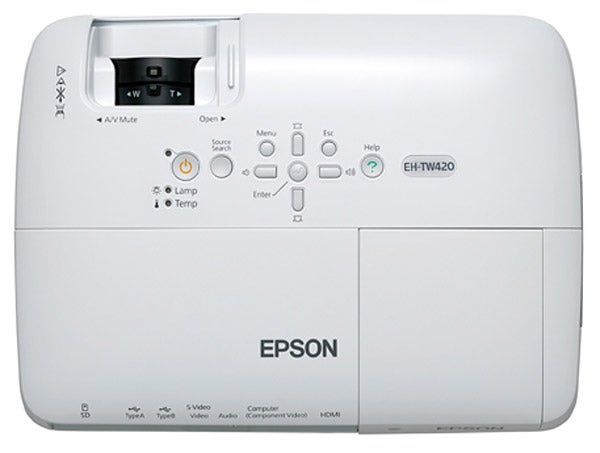
Heading into the TW420’s neat onscreen menus reveals one or two promising features. Particularly noteworthy is the long list of themed video presets, including Theater, living room and game options.
There’s also a surprising degree of colour management, which enables you to adjust the red, green and blue elements of the picture individually, and the inevitable (given that this is an LCD projector) ‘Auto Iris’ option whereby the projector can continually adjust the amount of light it emits in response to how bright or dark the image content is at any given moment. Without this trick, most LCD projectors struggle to show a convincing black level response – though it can also cause another problem, namely brightness ‘jumps’, if the iris system isn’t subtle or fast enough in what it does.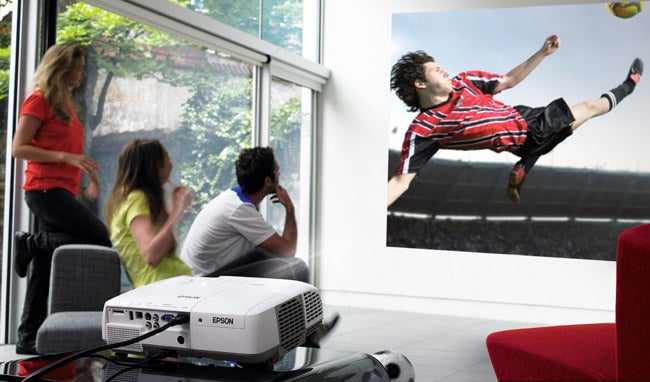
Other notable options include the facility to expand the HDMI video range (not recommended!), call in a reasonably effective auto keystone adjustment, switch the lamp output between high and low, and change the projector’s volume.
Change the volume? Indeed. For in a bid to make the TW420 more convenient as a portable projector, it ships with a built-in 7W audio output so that you’re not dependent on some sort of external sound system for your audio.
As ever, though, while this seems a great idea on paper, in reality such an arrangement leaves you with the ‘interesting’ situation of having the audio for your big old pictures being joined by a small soundstage emanating from a position potentially metres away from the pictures it’s supposed to be accompanying. Not exactly ideal, I think you’ll agree.
Settling down at last to check out what the TW420 can do, I very quickly run up against something else that’s not exactly ideal: the projector’s black level response. This is generally a problem for budget projectors, but the degree of grey clouding over dark scenes and dark parts of otherwise bright scenes is at times pretty depressing.
Take, for instance, the night-time shot across the bay of the two ferries The Joker has rigged with explosives in ”The Dark Knight”. The TW420’s lack of black level response makes even picking the outline of the boats out against the water a bit of an eye-strainer – and this is, of course, just one example of countless others during what is, after all, a predominantly dark film.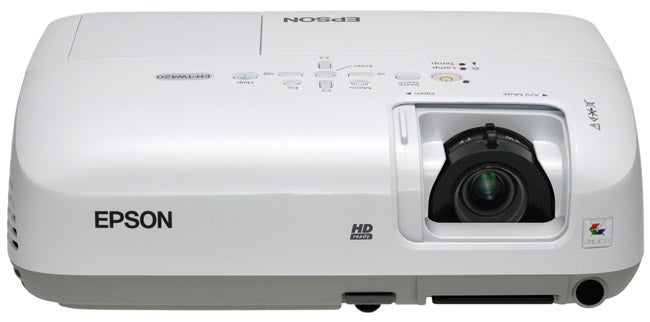
Obviously the TW420’s black level issues aren’t as pronounced or distracting if you’re watching something predominantly bright and colourful, such as ”Toy Story”. But of course, no self-respecting film fan is going to only watch bright animation, and for almost any other source type the black level issues are something I doubt that you’ll ever really grow acceptant of. Especially as they also lead to dark scenes looking a little flat and short of detail.
While examining the TW420’s black level response, I should add that I spotted a faint glowing circle over part of the image that I suspect is caused by a speck of dust somewhere in the projector’s lens barrel. Obviously it’s unlikely that another sample would suffer the same problem, but I mention it because it raises slight concerns about the build quality of the optical engine.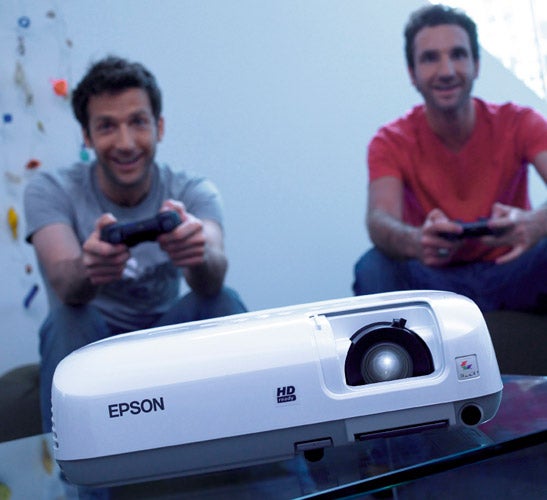
Another negative issue Blu-ray fans should be aware of with theTW420 is the fact that it can’t really handle 1080p/24. Pumping this into the projector results in some nasty horizontal tearing, similar to that seen with games on the PS3 or Xbox 360 that don’t employ sufficient V-Lock processing. This means you have to ‘make do’ with adjusting the Blu-ray output to a less pure1080p/60, or perhaps more logically given the TW420’s native resolution, 720p.
One final negative point finds the TW420 running really distractingly noisily when its lamp is set to its ‘high’ output. But then to be fair, precious few people reading this review will want to use this setting anyway, since the damage the high brightness setting does to the TW420’s already underwhelming black levels is really quite extreme. And with the lamp set to ‘low’, the running noise is actually not bad at all, even if you’re sat only a metre or two away from the projector.
The TW420’s black level shortcomings are made to look all the more unfortunate by the fact that in many other ways it’s actually a really quite decent performer.
HD images look surprisingly sharp, for instance, with good detailing and plenty of noiseless texture rendering despite the lack of Full HD resolution at the projector’s heart. It’s great to see at this price level, too, that the TW420 doesn’t suffer badly at all with LCD technology’s notorious ‘chicken wire’ effect, whereby the grid-like array of the LCD panels at the projector’s heart becomes manifest in the finished image. I vaguely sensed a square or two over really bright and really monotone areas of the picture, but never enough to become truly distracting, even when using a 110in screen.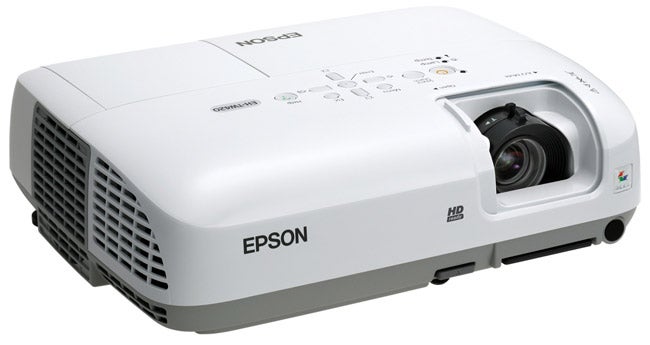
More good news finds the TW420’s onboard scaling doing a very credible job of both upscaling standard definition and downscaling 1080p high definition to its 720p pixel count, with minimal blurring, dot crawl or other noise to spoil the show.
Perhaps the biggest surprise, though, is how believable the projector’s colours are. Really vibrant palettes like those found in many video games or animated films really sparkle, partly on account of the projector’s unusually high brightness output, and partly because the projector’s colour tone really does seem to be calibrated with video rather than PC/multimedia in mind. Even without recourse to the sliding red, green and blue adjustments noted earlier.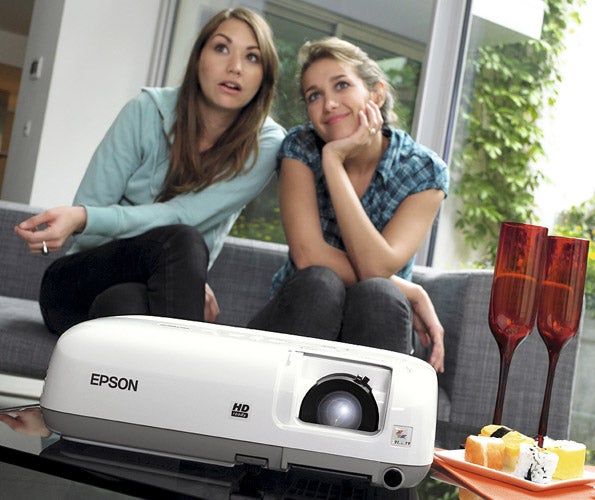
This preference for video colour temperatures inevitably stands the TW420 in even better stead with a typical, fleshtone-filled video scene, such as the main poker games of ”Casino Royale”. There’s only the slightest hint of the green undertone we often find at the TW420’s sort of price level, and practically no sign of all of that other common, cheap LCD tendency to overstress reds and pinks.
Even colour blends on the TW420 look subtler than I would have expected to find on a 720p (as opposed to Full HD) LCD projector. This fact, together with the projector’s sharpness, helps provide a little of the sense of depth lost by the black level shortcomings.
It’s worth stating too, for people pretty new to the whole projection game, that the TW420’s LCD nature precludes it from the rainbow effect phenomenon found to some extent on all cheap DLP projectors, whereby stripes of pure green, red and blue flit around in your peripheral vision an over particularly bright parts of the image.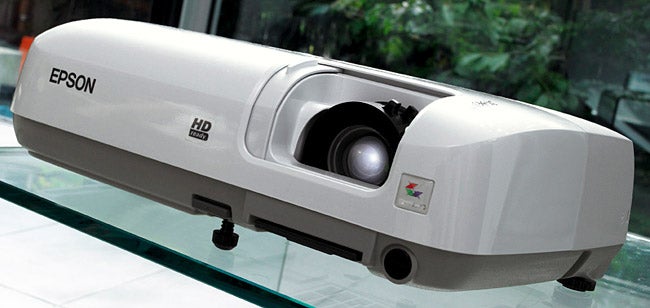
I’m going to lay my cards on the table here and say that I personally find DLP’s general superiority with black level more persuasive than LCD’s lack of rainbow effect. But I also acknowledge that there are definitely people out there who are so unusually susceptible to the rainbow effect that DLP is rendered pretty much a non-starter.
The last thing I should mention in passing is the TW420’s audio, for what it’s worth. The 7W of provided audio power does at least prove sufficient to reproduce even an action film scene without distortion, but a profound lack of bass leaves the soundstage tinny and unrealistic. Not that the sound was ever going to be big on realism given how far it is from the pictures it’s supposed to be accompanying, of course!
”’Verdict”’
Although ultimately let down by the classic LCD black level problem, there are certain shots and scenes where the TW420’s pictures look really very nice indeed. Which is enough, at the very least, to make me feel excited by what Epson’s imminent higher-end projectors might be able to do. Watch this space.
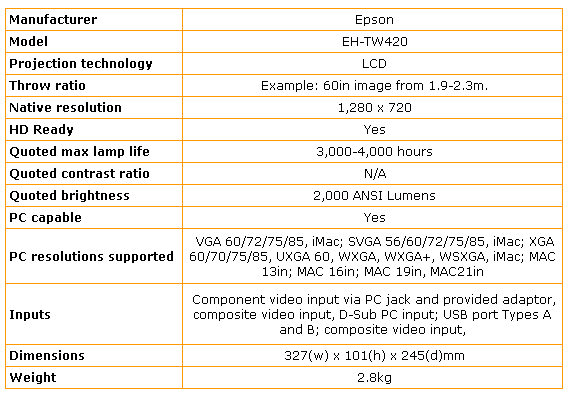
Trusted Score
Score in detail
-
Value 7
-
Features 6
-
Image Quality 6
-
Design 7

